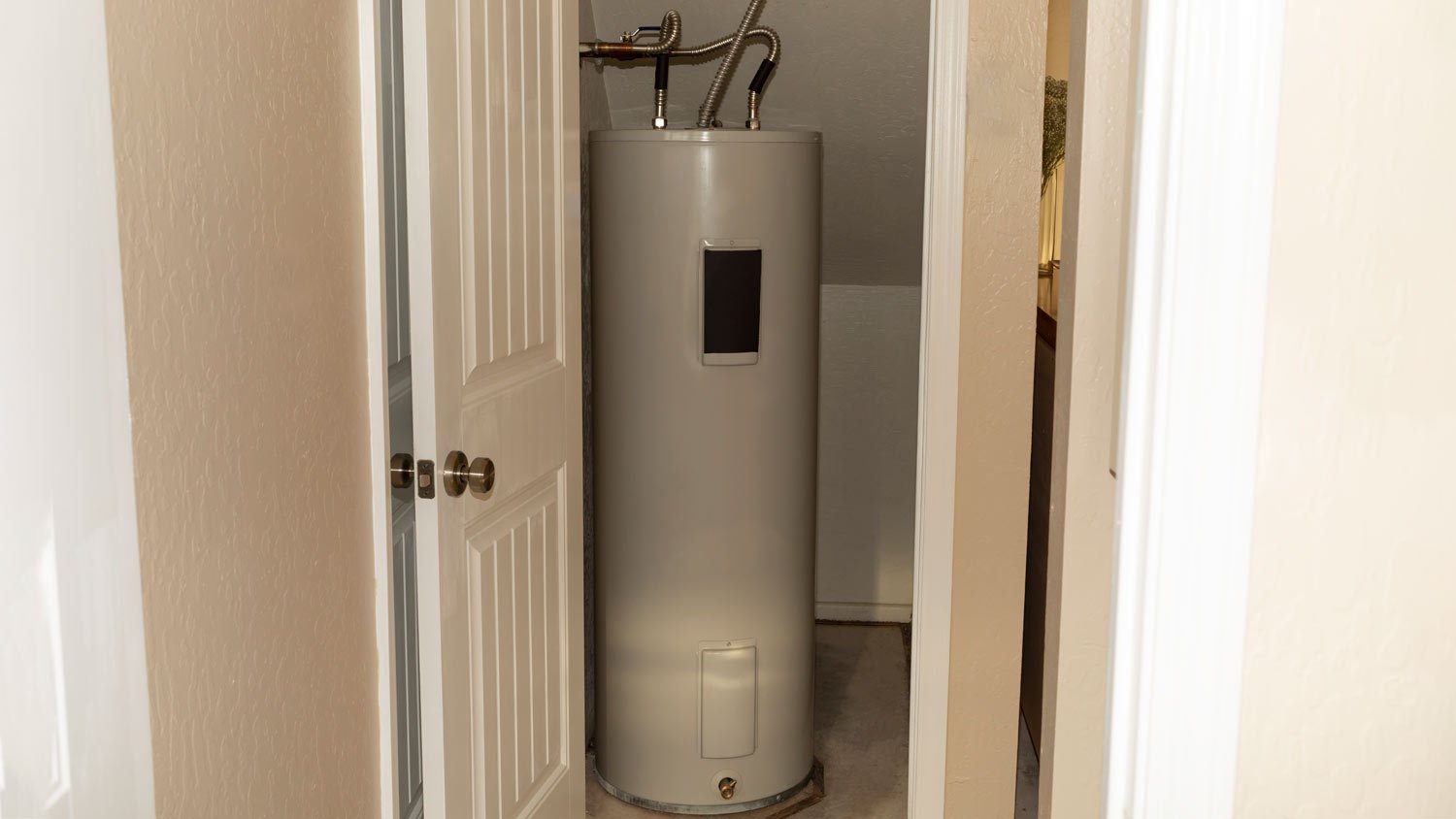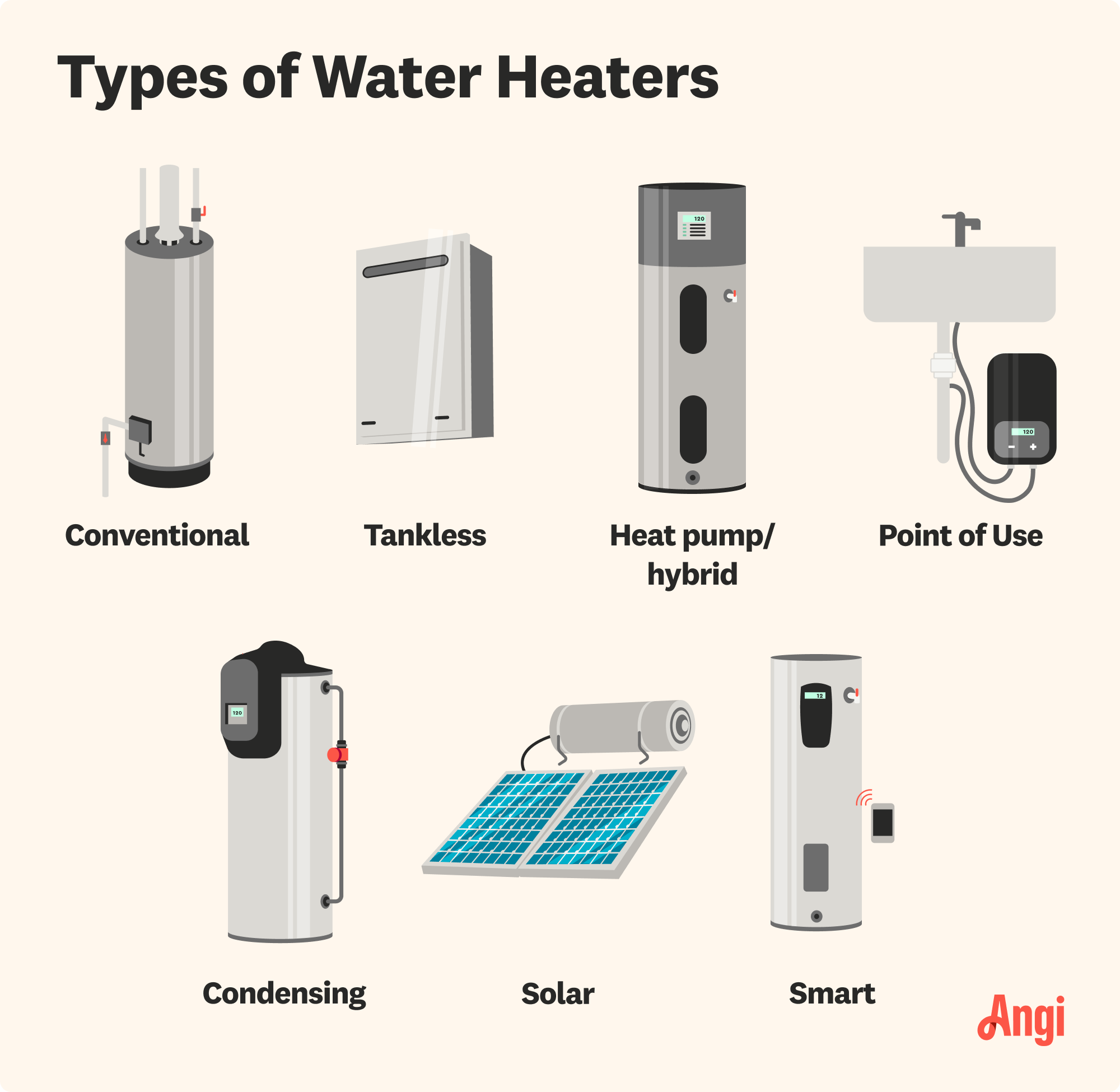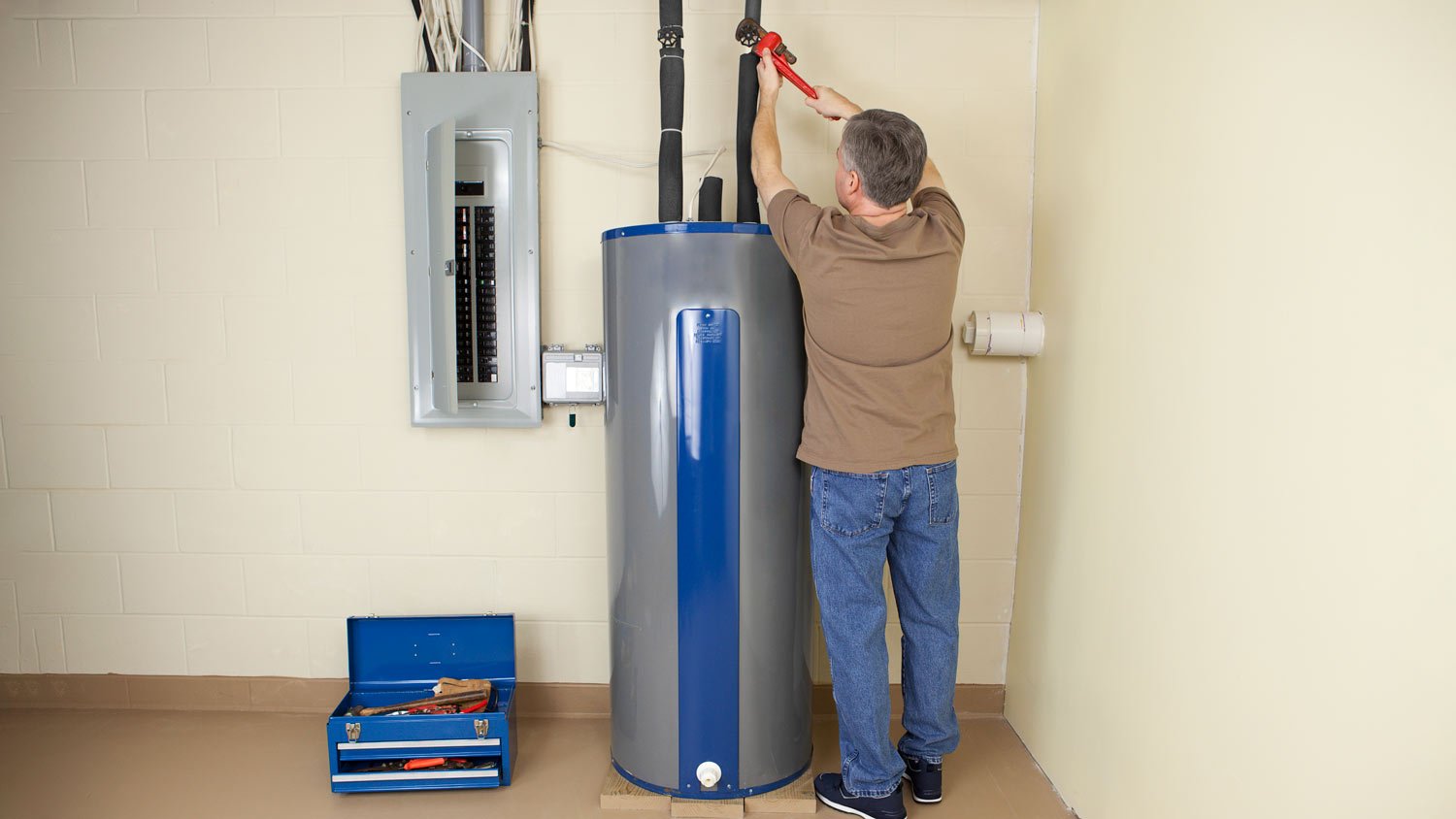How to Replace a Water Heater In Your Home in 7 Steps
Don’t get into hot water—only do this if you’re a seasoned DIYer


This project requires a lot of experience, so we don’t recommend DIYing it. Hire a pro with the special skills and tools necessary to complete the job safely.
- Appliance dolly
- Adjustable wrench
- Pipe wrench
- Screwdriver
- Channel-lock pliers
- New water heater and components
- Plumbing tape
- Plumbing fittings (optional)
- Copper pipes (optional)
- Shims (optional)
Learning how to replace a water heater may be a job you’d consider DIYing to save labor costs—but should you? We would not recommend doing this job yourself unless you have prior experience because of the challenges and risks involved when working with plumbing, natural gas, and electricity. Replacing a water heater requires following several precise steps—which we’ve outlined below. If it seems a little daunting, we’d recommend watching a professional do them for you instead of trying them yourself.

Prep Steps for Replacing a Water Heater
Putting in a new water heater is a challenging DIY job. Most homeowners will not have the skill or know-how required. To replace a water heater, you’ll have to disconnect and remove the old water heater. You’ll then bring in the new unit and level it before attaching it to the plumbing and fuel source. Because you’re working with potentially dangerous electricity or natural gas, hiring a professional is the best option for this job.
If you want to do the job yourself, you need to turn off the water and gas supply before you start working. You also need to turn off the circuit breaker serving the appliance.
Turn on the faucets throughout the home to bleed all the plumbing lines. Once all the water is out of the lines, turn off the faucets again.
Disconnect the Old Water Heater
 Photo: Tactical Toadfish / Adobe Stock
Photo: Tactical Toadfish / Adobe StockStart by draining the water out of the old appliance. For every 10 gallons of water in the unit, you will need at least 5 minutes.
You should be able to screw a garden hose onto the drain valve toward the bottom of the appliance. Run the other end of the hose into a floor drain or bucket. Slowly open the drain valve to release the water. Once all the water drains, close the valve and disconnect the hose.
Remove the appliance's water supply pipes. You should be able to unscrew the nuts with a pipe wrench. If they’re soldered into place, you’ll have to use a pipe cutter.
For an electric water heater, disconnect the hard-wired electric lines. The junction box is near the top of the appliance. (Use a voltage tester to be sure the wires are not live before working on them.)
For a gas water heater, you must disconnect the gas supply line. You should be able to unscrew the coupling nut with a pipe wrench. (Use a gas leak detector to keep yourself safe in case something is wrong with the supply line.) Gas units should have a vent hood. Unscrew the hood and vent pipe from the old appliance.
Move the Old Water Heater
With everything disconnected, tip the old water heater onto an appliance dolly and strap it in place. In some locations where earthquakes are possible, you may need to disconnect a few stabilization straps or brackets before tilting the old unit.
Move the old water heater well out of the way, giving you room to align the new unit. You can sweep and clean the flooring after removing the old appliance.
Bring in the New Water Heater
 Photo: William A. Morgan / Adobe Stock
Photo: William A. Morgan / Adobe StockUse the appliance dolly to bring the new water heater into place. (Remove any packing materials before you attach it to the dolly.)
Before removing the dolly, align it so the connections on the new water heater line up as close as possible with your existing infrastructure locations. Use shims if necessary to level the appliance.
If you’re installing a tankless water heater, you’ll need to mount it to the wall according to the instructions.
Install the Fittings
Your new water heater may need a little work before you can hook it up. You could have to put in the fittings yourself, like the pressure relief valve. Read the instructions carefully to be sure you’re installing everything properly.
Attach the Water Lines
Inspect the cold and hot water lines. If you have threaded nuts on them that will fit perfectly onto the new water heater, wrap the threaded connectors on the appliance in plumber’s tape to create a leak-free connection. You can then screw the supply lines in place and tighten them with channel-lock pliers or a pipe wrench.
If they don’t fit perfectly, don’t force them into place or you risk major leaks. You may have to attach new plumbing fixtures to the ends of the lines. If the water lines are too short, you will have to solder a new connection. These are steps best left to a licensed plumber.
Attach the Fuel Source
 Photo: BanksPhotos / istock / Getty Images
Photo: BanksPhotos / istock / Getty ImagesYou now need to attach your source of power to the new water heater.
Connecting an Electric Water Heater
For an electric water heater, remove the cover from the connection box near the top of the unit. Use fresh wire nuts to connect the electrical supply wires to the water heater’s wire leads. Replace the cover on the connection box.
If you believe the wires are connected properly, turn on the circuit breaker and test the wiring with your voltage tester.
Connecting a Gas Water Heater
Connect the gas supply line to the water heater’s burner control valve. If your gas line isn’t long enough or you don’t have one, you’ll need to hire a plumber to run a new gas line.
Turn on the gas supply and use soapy water to check for leaks at any connections and joints. Use the gas leak detector to monitor for leaks, too.
If you don’t have any leaks, connect a vent pipe and draft hood to the top of the gas water heater. Use screws to attach the draft hood.
If the current vent pipe is too long, you can trim it to the right length with a reciprocating saw or pipe cutter. If you don’t have a vent pipe or if it’s too short, you’ll have to add one or lengthen it. Hiring a plumber is the best choice for this work.
Then follow the manufacturer’s instructions for turning on the pilot light.
Turn on the Water Heater
If you are sure the fuel supply is safely connected, you can turn on the water supply. Allow the tank to fill completely. Most water supplies deliver at least 4 gallons of water per minute to the tank. Once you believe it’s full, you can turn on a nearby hot water faucet and see if water runs. (You may have a bit of air in the line that will need to clear first.)
Gas water heaters take at least 30 minutes to heat a 40-gallon tank to the desired temperature, while electric water heaters need at least 60 minutes.
Avoiding Mistakes When Replacing a Water Heater
Trying to DIY water heater replacement could lead to dangerous mistakes.
If you don’t have the right tools, skills, or experience to replace a gas water heater, you could end up with a gas leak or an explosion.
Gas water heaters require a vent pipe, and the failure to install the vent properly could lead to carbon monoxide exposure.
Replacing an electric water heater incorrectly could lead to electrical shock or fire.
If you don’t connect the water heater to the plumbing system correctly, you could experience major water leaks or plumbing damage.
Hiring a local plumber to replace the water heater is a smart choice to avoid potential mistakes.
When Should You Replace a Water Heater

When your water heater is 10 years old or older, you should consider replacing the water heater. Most of these appliances last 10 to 20 years. When you have an older water heater, and the cost to repair it is significant, consider a replacement instead.
Signs that your water heater is nearing the end of its lifespan include:
Constant repairs
Fluctuating water temperatures
Discolored water
Leaks from the appliance
Popping, banging, or similar sounds
DIY vs. Hiring a Pro
Because this job is difficult to do safely, only the most experienced and skilled homeowners should try it. To DIY replace a water heater, significant experience with plumbing systems, natural gas hookups, and electrical work is necessary. Not to mention, water heaters are heavy even when empty and may require more than one person to lift and move them.
Some local building codes do not allow unlicensed professionals to replace a water heater.
Who can install a water heater for you under local regulations? You can hire a local water heater installation company to do the work.
The average water heater replacement cost is $900 to $1,800 and labor costs average $150 to $450 of that amount. However, you could spend several thousand dollars for certain types of water heater designs, and the labor costs for installing them would increase as well.
Frequently Asked Questions
Instead of replacing the water heater, you can consider repairing your current appliance. Learning how to do DIY repairs, such as replacing a water heater element, can be extremely challenging. You’ll want to rely on a plumber to inspect your water heater and help you decide whether replacement or repair is the better option.
When it’s time to replace your water heater, the professional installing the new one will often dispose of the old unit for you. However, if your old appliance gets left behind or if you do the installation yourself, you’ll need to find a way to dispose of it. Some recycling centers or scrap metal yards will accept old water heaters. Always call ahead to determine whether the center will accept your unit. Otherwise, ask your local landfill or trash-hauling service for ideas on what to do with the old appliance.
When replacing an old unit, you might want to switch from a gas water heater to an electric water heater or vice versa. To do this, you will likely need to add infrastructure to the area. For example, you likely don’t have a gas line that served your old electric water heater. You’d have to call a plumber to put in a new gas line. If you’re replacing a gas unit with an electric one, the plumber will need to safely cap the old gas line. You will then need an electrician to add wiring for the new electric unit.















